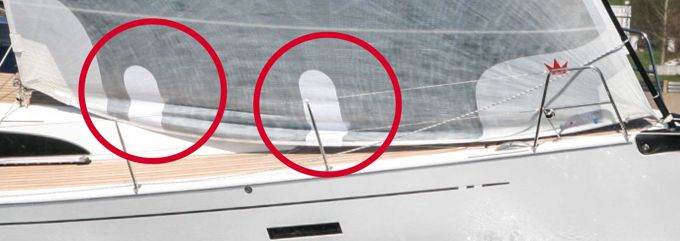
There are a lot of patches or reinforcements in sails. Your new sail will be equipped and delivered with reinforcements in the corners of the sail and at reef points. These are extra layers of cloth to make the sail strong enough for the attachments to stay in the sail, when under load.
The patches that you as a sailor need to deal with yourself are often referred to as spreader patches.
Spreader patches for mainsails
Spreader patches for mainsails are normally shaped like a circle. The outer layer is insignia, if possible, in a quite equal color to the sail.
The inside of the patch must be of a more solid material (polyester, dyneema or aramid).
The best way to mark where to mount the patches is to hoist the sail and have a person to climb the mast and mark on the sail. If the sail is equipped with reefs, you need to patch the reef points as well.
For racing sails, that are built from light materials, it is essential to protect the sail on these points. For long distance cruising, where you may sail several days with the sail resting on the spreaders, it is also essential. Traditional woven cloth for typically cruising use is solid, so these patches are not mandatory on that sail type.
Spreader patches for in-mast furling mainsails are around 30 cm high, and with a length that covers the sail both when full and furled. If you have battens in the sail, keep an extra eye on the batten pockets. Over time, it may be necessary to add some small extra patches on the batten impact points.
Spreader patches for overlapping headsails have 2 purposes. It is important to have impact patches shaped as circles where the sail hits the spreader end, but it is also important to have a strip at around 3% height of the leech length that covers and protects from the front of the impact patch and all the way to the leech. When tacking, this insignia strip will protect the sail surface and make sure that the leech tape cannot catch anything when passing.
Stanchion patches are shaped equal to the overlapping genoa patches, with solid impact circle patches covered by an insignia strip.
It is a good idea to patch your sail before it wears trough the sailcloth. You know that it is time to change the patch when you can see the sailcloth trough the patch. When replaced the area will look as new again and ready for you to enjoy another couple of seasons.
In general
In addition to the above you should in general watch out for are chafe points, like e.g., Radar-installations. If the leech overlaps the backstay the sail might need some protection as well.
Look at your sail from time to time, and if you see marks on the surface, it might be worth applying a patch of insignia. In general, when you apply patches, make sure that the sail is fully stretched, and that the patch is not applied tightly on to the sail. If mounting the patch tighter than the sail, the shape of the sail may be affected.
A patch type, that you may consider purchasing with your fully battened mainsail is a webbing reinforced batten pocket. If you don`t have reefs, you don`t need this option, since you have very few impact points.
If you have a boat with several spreaders, and maybe also cap shrouds going out to the extremities of the e.g. a multihull, combined with for instance 3 reefs, you have so many impact point that this option is well worth it. Remember however, that when this patch has done its job, it needs to be changed by a sailmaker.
With the Elvstrøm Sails accessory bag we deliver regular repair patches with mainsails with horisontal battens. They might come in handy. Otherwise contact your local Elvstrøm SailPoint for specific patches as described above.